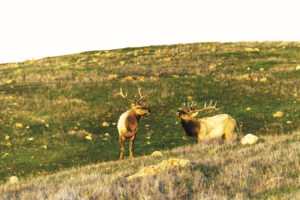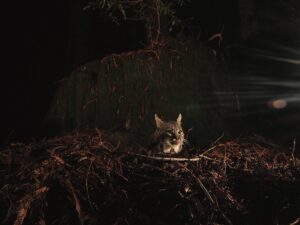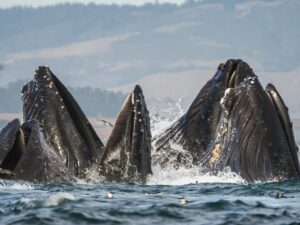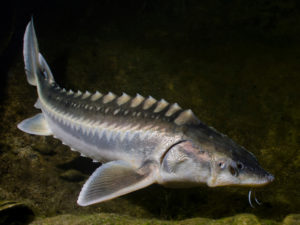f fishing excuses any absurdity, as the writer Randy Wayne White once wrote, then there is no excuse needed for the small chunk of chocolate iced donut that has, in the name of science, just splashed into a pond in the South Bay.
We were visiting in the early spring, when there was enough early morning sunshine to warm the water, coax the fish out of their lethargy and remind them that they were hungry enough to bite down on a piece of squid dangling on the end of a hook. Except for whatever reason it hadn’t; five hours of fishing, zero hints of quivering line.
So Jim Hobbs walked across the levee to a pink box of donuts resting beside a fishing pole. He grabbed a donut – a survivor of five hours in proximity to fishing scientists – broke off a piece and flung it into the pond. “You guys didn’t make the donut sacrifice, did you?” Hobbs said. As the dough disintegrated into the brackish water, he stuffed the rest of it into his mouth.
It is really in the waiting that the absurdity begins. When you are with Hobbs, hanging on the whim of a leopard shark, there will surely be a lot of both.
r. James Hobbs, a research scientist at UC Davis, is studying the response of fish to the restored habitat of the South Bay Salt Pond Restoration Project, the largest wetland restoration west of the Mississippi. Hobbs and his colleagues have spent many weekends in typical ecology pursuits: setting up gill nets, taking sediment samples, and corralling fish populations for data. But for a biologist whose email signature reads “better science through fishing,” the study would not be complete without a fishing rod and in this case, one of the Bay’s top predators, the leopard shark.
When the first Europeans arrived in the San Francisco Bay Area in the 18th century they were in fact arriving at the Big Apple of pickleweed. At that time the bulbous green and sometimes brilliant red perennial covered an area the size of New York City, and the wetland ecosystem it dominated provided habitat for migratory waterfowl, shorebirds, and various fish species – among them the leopard shark. But over the centuries agriculture, development and commercial salt production reduced the pickleweed and tidal marsh habitat to a fraction of its former glory. Since the 1980s it has been the consistent goal of regional, state and federal agencies to reverse that decline, and in 2003 a consortium of government agencies acquired 15,000 acres of land from the Cargill Salt Company to restore to tidal marsh, mudflat and wetland habitats. Work on the Cargill ponds began in 2008 and has turned the land into a mosaic of different habitat types: there are fully breached levees creating tidal wetlands, partially breached levees creating ponds with muted tides for shorebirds and migratory waterfowl, and ponds that use water level control structures to create deeper water for diving ducks. It’s not a revival of the landscape that once was, but the creation of our own novel ecosystem: something people decided was valuable. It is in part Hobbs’ job to say whether these marshes we’ve created are the right kind of help for us to offer nature, in particular, the fish communities that live in the South Bay.
“This area is still very productive,” says Hobbs. “But it’s not a natural habitat.”

obbs arrives at one of the prime restoration spots, Eden Landing Ecological Reserve, in a canary yellow SUV. It was a gusty spring morning and around him duck hunters were hauling camouflage out of trucks. “Not much of an Eden, huh?” Hobbs said as we piled into the car. Acres of muddy water sprawl off toward the Peninsula, bordered and broken by pickleweed and further divided by concrete levees and riprap. Hobbs maneuvers the windy levee bends with a steady stream of facts, observations and jokes, narrating the scenery with the authority of a scientist and the humor of fisherman, of which he is both. Outside, the sparrows flit and fly to the bang of gunshots while avocets and stilts tip toe through the mud in search of food. Here, the birds sing the loudest — at meetings, as Hobbs likes to say, he is often the only fish guy in a room full of birders. His fish of choice, though, is a fish to be reckoned with: stout, steel-gray and mottled with dark brown bands and spots, the leopard shark is the Bay’s most charismatic species. While they have always called the South Bay home, the levee breaches have allowed the sharks to make it more of a permanent habitat without getting caught on the mudflats at low tide.
These breaches have also become “sites of predation” as Hobbs says, or something of a buffet, funneling small fish and mealworms into the open mouths of waiting leopard sharks. And that’s exactly what Hobbs is most interested in — what’s inside their stomachs. Inside the stomach of a leopard shark, you find the full range of the bottom of the food chain in the restored salt ponds, and one of the best ways we have of estimating the success of these restoration projects.
After 20 minutes of driving we step onto the levee by pond E9. The marsh extends before us in a patchwork of red pickleweed, white crushed rock and quicksilver water. From here, facing northwest, the San Mateo Bridge cuts across the horizon, ferrying drivers to Redwood City over the choppy waters of the Bay. On the levee, Hobbs’ colleagues have already set up their research equipment: a small tin boat bobbing in the water, a gill net pulled across the pond between a buoy and an anchor and five candy-cane striped fishing poles, baited and wedged into the riprap, their hooks out of sight. The pink donut box sits nearby.
In the middle of the levee a fold out table is covered with boxes, jars and two water pumps — the kind you find at Home Depot, Hobbs says. The technique they are employed in, in scientific parlance, is called “gastric lavage.” What that means is, “make the shark throw up and save what comes out.” The process goes something like this: catch the shark, identify the shark, measure and weigh the shark, tag the shark then, make the shark vomit. Unlike humans, leopard sharks don’t have a gag reflex, so when water is pumped into their stomachs they become so full that everything has to come back out. What comes out is then poured into a bucket, transferred to a pickling jar, mixed with formaldehyde and taken back to the lab for analysis. The sharks, lighter but not particularly the worse for the experience, are returned to the water.
“They probably think, ‘Damnit, it took me an hour to find all that food,’” Hobbs says.
eopard sharks are a convenient research subject for biologists: they have very small teeth that are mainly used for crushing so the process of hauling them out of the water and examining them closely is not necessarily a dangerous one. The biggest risk as Hobbs explains, is bright red forearms caused by handling slippery fish with sandpaper scales.
There is also, though, the psychological risk: these are researchers who spend their days waiting for fish to bite, wrestling sharks when they’re successful, and then catching shark vomit in jars. It is, even at its most serious, absurd. And the day’s running joke is that Jim Hobbs, dressed immaculately in plaid shirt and a pair of slacks appropriate for the swing dance floors he graces on the weekends, is not usually this clean. “This is the least mud we’ve seen on Jim in a long time,” says Hobbs’s colleague Felipe LaLuz.
Hobbs is generally the first person to get his waders dirty, the first to wrangle a spineless shark, the first to drag a heavy net through sticky mud. Clean clothes are for the evenings. (“Fish all day, dance all night,” another researcher, Pat Crain, had joked.) Or, when you’re working in a sterile lab. Scientists and journalists, of course, grapple all the time with the effects observers have on their subjects; today Hobbs has hung up his swing dancing shoes and left his waders in the trunk to become not only the protagonist but the narrator of the day. That leaves it to LaLuz, covered to the waist by a pair of damp, muddy rubber waders, to trudge out of pond E8X, dragging a seine net behind him. Hobbs, from the levee, explains that the seine trawl samples what is actually found in the pond and can then be compared to what’s inside the shark’s stomach. The net comes back sprinkled with silversides, clear jellyfish and one young English sole, all of which are counted, measured and tossed back into the pond.
“That’s what ecology is,” Hobbs had said, watching his colleague Jon Cook kneeling by the levee, plucking fish from the net. “Counting things.”
And waiting.
Before LaLuz and Cook waded into the brackish water, Hobbs and Crain reeled in the five lines to check what was biting. It was mid-morning and the sun had warmed the water to where the researchers hoped the sharks were awake. The lightness of the poles, though, indicated otherwise. Two were void of the sinewy, pink toned squid used as bait. Hobbs realized no one had made the donut sacrifice. He remedied the situation, and returned to waiting.
Eventually, LaLuz and Cook finished their seining. They stood in the muddy shallows, rinsing the net before jamming it into a bucket. Side by side, they moved through the sludge with flat feet and grubby hands, dragging their legs back to dry land. Field work is often seen as the Indiana Jones side of ecology; adventurous and action packed. But more often than not it is exactly this: strenuous, dirty, wet. So while LaLuz and Cook were spritely enough, neither of them was smiling.
Hobbs chuckles, as is his way. “You love it, don’t you Felipe?” he says. Which Felipe does, of course, even though this is also manifestly a clean, dry Hobbs projecting his own passion.
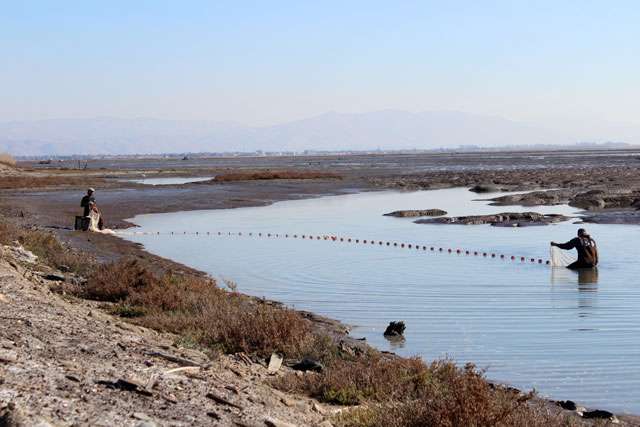
here was a particular Saturday last September. A hell of a Saturday. A 20 knot wind. Rain coming down in sheets. The researchers were completely soaked: water inside their waders, water in their eyes, water in the boats. But they just kept reeling the leopard sharks in. It is easy to image Hobbs grinning through the deluge, wrangling shark after shark. And it was a great day for science, with jar after jar of shark vomit filled and tagged and sent off to the lab.
As it turned out, it was also a meaningful day for Hobbs personally: his last time fishing with his friend, Joel Herranz Lotilla. “Mooch,” as he was known at the Nor-Cal Kayak Anglers club — where he was the guy, Hobbs explains — passed away shortly after that day in the deluge. So for Hobbs it was important to be there with him, to fish with him, to watch him catch that last fish of the day even while around them the rain clapped loud and hard and fast. Fishing is full of such stories. Even when the point of the fishing is to yield jars of shark vomit to evaluate the success of wetland restoration, it’s still fishing. It still excuses absurdities.
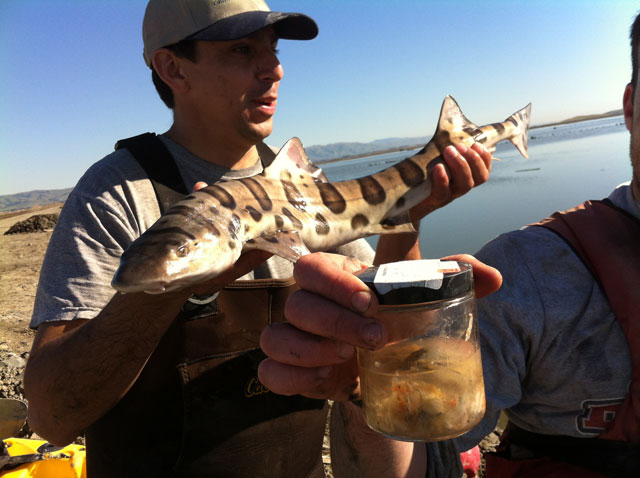
nce the jars are back in the lab it is the job of Allan Webster, an undergraduate research assistant, to try and distinguish what is what inside of them. Webster says it can take up to four hours to sort through a single jar which normally contains heads, bodies or whole mealworms, longjaw mudsuckers, and maybe even pieces of smelt. Webster also drops red dye into the jars of sediment as they’re collected. The dye, he explains, binds to anything living, making it easier to sort through later. This diet analysis helps researchers determine the quantity and quality of food available to predators in the restored marsh compared to unrestored sloughs and ultimately, help assess the success of the restoration for fish species.
Leopard sharks have always been a South Bay fixture but the restoration at Eden Landing has encouraged a rise in their numbers. Due to insufficient historical counts there is no concrete data to show population trends over time however, Hobbs says there are some good signs. Pond E8 now serves as a nursery habitat and most of the sharks caught there are juveniles, fattening up at the breach before moving elsewhere in the Bay. (These young ones, Hobbs says, are real cute.) The UC Davis lab has even received phone calls from fisherman who have caught the tagged sharks as far as Candlestick Point. According to Hobbs, the study is a great way to look at how the restoration is quickly benefitting the area’s top predators, and as the ponds become more productive that productivity will then be exported to the Bay as a whole.
While today’s focus has been leopard sharks, the project is part of a broader study looking at the response of fish communities to salt pond restoration. Hobbs and his team have looked at other apex predators in the South Bay including bat rays and striped bass. But among the less charismatic species being studied is the aptly named, longjaw mudsucker. Residing solely in intertidal salt-marsh habitats, this species of goby is a sort of pickleweed specialist and can act as an indicator of the health of such ecosystems. At Eden Landing the longjaw mudsucker’s presence is signposted by a series of holes punctured into the walls of the pond, where the males have dug their burrows. “Then they just flare out these big ol’ jaws to attract a female,” Hobbs says.
Prior to the leopard shark study the team used minnow traps sprinkled with cat food to attract and count longjaw mudsuckers across the South Bay. Much like their land counterparts — the Ridgway’s rail and the salt marsh harvest mouse — longjaw mudsuckers thrive in intertidal, pickleweed dense areas. Eden Landing is not yet such a site and although they are present, their abundance remains low.
There are plenty of fish species in the Bay — plenty to be studied, counted, analyzed — and after more than a year of apex predators, Hobbs has shifted his focus. Weekends are now spent at pond A8 at the junction between San Jose’s Guadalupe River and Alviso Slough. Hobbs, Cook and LaLuz are microchip tagging young steelhead trout and tracking their movements with radio antennas. The purpose of the study is to monitor whether the smolts are being trapped in the A8 tide gate and the results will inform the continued restoration of the three-pond complex at the mouth of the river. It is a study markedly more high tech than a fishing rod, a chunk of squid and a water pump but the basics are still there. There is the fish, mottled and iridescent steelhead trout; there is Hobbs and his team, rubber waders and fishing caps in tow; and there is of course, the Bay.
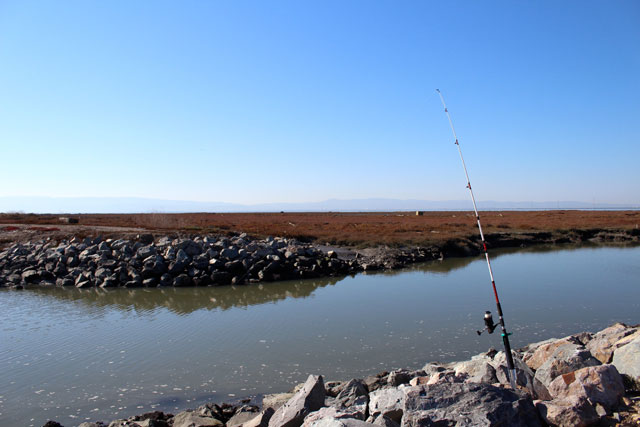
t is noon and LaLuz is in a yellow kayak checking a possibly curving gill net strung across the pond. He prods it with the end of his paddle, lifting its top section out of the water. It is empty. By now, the water is moving, and in the distance a steady stream of cars traverse Interstate 880. Webster is looking through a pair of binoculars, trying to identify the skittish birds in preparation for an upcoming exam. Crain begins reeling the lines in again. The first line seems taut, almost heavy.
“I thought you had something there for a minute,” says Cook, looking at the clean, curved hook.
More bait has been eaten away but all five lines come out with no sign of a leopard shark. The day more or less follows this pattern: take samples, count fish, check lines. There are, of course, many diversions: debates on the state’s water problems, whispers of heading to Five Guys on the way back, and a quick swing dancing demo courtesy of Hobbs. But there are no leopard sharks. The donut sacrifice has failed. Hobbs attributes the zero to low levels of dissolved oxygen caused by nutrient rich water sitting in the pond and slowly cooking. The leopard sharks it turns out, don’t like that. But for now, that’s no matter. Zero is still a data point. And there are more areas to be seined, more minnow traps to lay, more steelhead to tag, more absurdity to chase.


